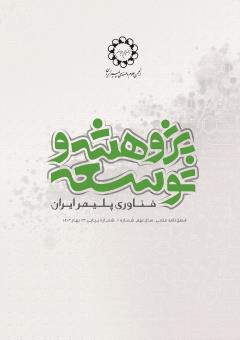تأثیر افزودنی ها و مستربچ جهت بهبود خواص پلیالفین های بازیافتشده
محورهای موضوعی : پلیمرهای بازیافتی و مدیریت زبالهحمیدرضا حیدری 1 * , مریضیه حسینی 2
1 - دانشگاه صنعتی امیرکبیر
2 - پژوهشگاه پلیمر و پتروشیمی ایران
کلید واژه: پلاستیک, بازیافت, مستربچهای افزودنی, خواص فیزیکی و مکانیکی, پلیالفین,
چکیده مقاله :
اگرچه بازیافت محصولات پلیمری برای محیطزیست و اقتصاد مفید است، اما هدف اصلی دستیابی به کارایی پلیمرهای خام (دستنخورده) در پلیمرهای بازیافتشده است. بهترین نوع بازیافت برای داشتن حداکثر کارآمدی انرژی و حداقل پیامدهای زیستمحیطی، بازیافت از نوع مکانیکی است. با این حال، یکسری تفاوت بین پلیمرهای دستنخورده و بازیافتی وجود دارد. بهدلیل تغییرات ساختاری و وجود ناخالصیها در پلیمر، رسیدن به یک بازیافت با کیفیت سخت است. اینکه پلیمر بازیافتشده برای بهدستآوردن کاربردهای جدید مناسب است یا خیر، توسط آزمونهای مکانیکی (مانند آزمون کشش، ضربهپذیری) و آزمونهای فیزیکی (مثل پایداری هیدرولیکی، زبری سطح) و آزمونهای عملیاتی (اکستروژن و قالبگیری) در شرایط استاندارد سنجیده میشود. وقتی آزمونهای بالا صورت گیرد، اکثر پلیمرهای بازیافتی الزاماتی را که برای کاربردهای مختلف نیاز دارند برآورده نمیکنند، مگر اینکه از افزودنیهایی استفاده کنیم که خواص آنها را بهبود ببخشد. این افزودنیها ممکن است شامل عوامل جفتکننده، بهبوددهندههای ضربه، غیر فعالکنندههای فلزی، تنظیمکنندههای جریان مذاب، آنتیاکسیدانتها، مستربچها و غیره باشند و هر کدام به طریقی موجب بهبود ویژگیهای خاص پلیمرها استفاده شوند. اگرچه بازیافت محصولات پلیمری برای محیطزیست و اقتصاد مفید است، اما هدف اصلی دستیابی به کارایی پلیمرهای خام (دستنخورده) در پلیمرهای بازیافتشده است. بهترین نوع بازیافت برای داشتن حداکثر کارآمدی انرژی و حداقل پیامدهای زیستمحیطی، بازیافت از نوع مکانیکی است.
Although the recycling of polymer products is beneficial for the environment and economy, the main goal is to achieve the efficiency of raw (intact) polymers in recycled polymers. The best type of recycling to have maximum energy efficiency and minimum environmental consequences is mechanical recycling. However, there are a number of differences between virgin and recycled polymers. Due to the structural changes and the presence of impurities in the polymer, it is difficult to achieve a quality recycling. Whether the recycled polymer is suitable for obtaining new applications or not is measured by mechanical tests (such as tensile test, impact test), physical tests (such as hydraulic stability, surface roughness) and operational tests (extrusion and molding) under standard conditions. When these tests are performed, most recycled polymers do not meet the requirements required for various applications, unless we use additives that improve their properties. These additives may include coupling agents, impact improvers, metal deactivators, melt flow regulators, antioxidants, masterbatches, etc., and each is used in some way to improve specific properties of the polymers. Although the recycling of polymer products is beneficial for the environment and economy, the main goal is to achieve the efficiency of raw (intact) polymers in recycled polymers.
1. https://insights.globalspec.com/article/14792/how-to-recycle-polymer.
2. Geyer, R., Jambeck, J. R., & Law, K. L. “Production, use, and fate of all plastics ever made”. Science advances, 3(7), e1700782, 2017.# 3. Pfaendner, R. “Additives to upgrade mechanically recycled plastic composites”. In Management, Recycling and Reuse of Waste Composites. Woodhead Publishing, pp.253-280, 2010.
4. Ding, Q., & Zhu, H. “The key to solving plastic packaging wastes: Design for recycling and recycling technology”. Polymers, 15(6), 1485, 2023.
5. Akbari, M., Zadhoush, A., & Haghighat, M. “PET/PP blending by using PP‐g‐MA synthesized by solid phase”. Journal of applied polymer science, 104(6), 3986-3993, 2007.
6. Geyer, B., Lorenz, G., & Kandelbauer, A. “Recycling of poly (ethylene terephthalate)–A review focusing on chemical methods”. Express Polymer Letters, 10(7), 559-586, 2016.
7. Strangl, M., Ortner, E., & Buettner, A. “Evaluation of the efficiency of odor removal from recycled HDPE using a modified recycling process”. Resources, conservation and recycling, 146, 89-97, 2019.
8. Strangl, M., Fell, T., Schlummer, M., Maeurer, A., & Buettner, A. “Characterization of odorous contaminants in post‐consumer plastic packaging waste using multidimensional gas chromatographic separation coupled with olfactometric resolution”. Journal of separation science, 40(7), 1500-1507, 2017.
9. Zdiri, K., Elamri, A., Hamdaoui, M., Harzallah, O., Khenoussi, N., & Brendlé, J. “Reinforcement of recycled PP polymers by nanoparticles incorporation”. Green Chemistry Letters and Reviews, 11(3), 296-311, 2018.
10. Latkin, C.A., Dayton, L., Yi, G. and Balaban, A., “The (Mis) Understanding of the Symbol Associated with Recycling on Plastic Containers in the US: A Brief Report.” Sustainability, 14.15, 9636, 2022.
11. https://www.plasticsforchange.org/blog/which-plastic-can-be-recycled.
12. Geyer, B., Lorenz, G., & Kandelbauer, A. “Recycling of poly (ethylene terephthalate)–A review focusing on chemical methods”. Express Polymer Letters, 10(7), 559-586, 2016.
13. Güçlü, G., Yalçınyuva, T., Özgümüş, S., & Orbay, M. “Hydrolysis of waste polyethylene terephthalate and characterization of products by differential scanning calorimetry”. Thermochimica Acta, 404(1-2), 193-205, 2003.
14. Geyer, B., Lorenz, G., & Kandelbauer, A. “Recycling of poly (ethylene terephthalate)–A review focusing on chemical methods”. Express Polymer Letters, 10(7), 559-586, 2016.
15. Awaja, F., & Pavel, D. “Recycling of PET”. European polymer journal, 41(7), 1453-1477, 2005.
16. Kratofil Krehula, L., Hrnjak-Murgić, Z., & Jelenčić, J. “Study of masterbatch effect on miscibility and morphology in PET/HDPE blends”. Journal of Adhesion Science and Technology, 29(2), 74-93, 2015.
17. Clarke, J., Clarke, B., Freakley, P. K., & Sutherland, I. “Compatibilising effect of carbon black on morphology of NR–NBR blends”. Plastics, rubber and composites, 30(1), 39-44, 2001.
18. Lindqvist, K., Andersson, M., Boss, A., & Oxfall, H. “Thermal and mechanical properties of blends containing PP and recycled XLPE cable waste”. Journal of Polymers and the Environment, 27, 386-394, 2019.

